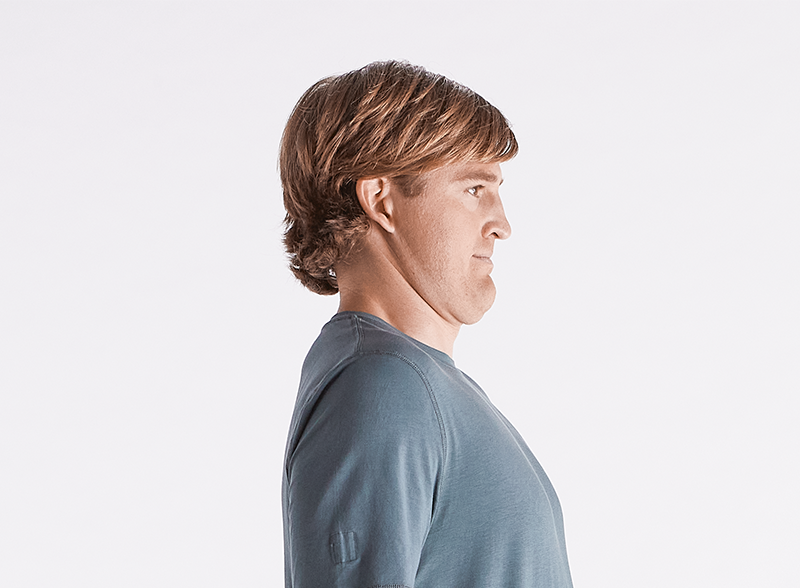How to Do Chin Tucks: A Hinge Health Guide
Learn how to do a chin tuck exercise to help with neck strength and flexibility, plus modifications to make it easier or harder.
Table of Contents
Whether you find yourself stuck in the same position at your desk for most of the day or you’ve been unusually stressed out lately, many people experience neck tension at some point in life. But simple exercises that strengthen and stretch your neck muscles can help prevent headaches and neck pain, making it easier to sit, rest, and move comfortably. One very effective exercise for improving strength and flexibility in your neck is the chin tuck.
Here, learn more about the benefits of chin tucks, plus how you can modify this exercise to suit your needs.
Tap into pain relief. Anytime, anywhere with our app.
Our Hinge Health Experts
Dylan Peterson, PT, DPT
What Are Chin Tucks?
Chin tucks involve gently moving your head and bringing your chin toward your chest, as though you’re nodding slowly. This movement can improve neck strength and flexibility over time so it’s easier to rest and move without pain.
What Muscles Do Chin Tucks Work?
Chin tucks activate and strengthen the muscles in front of your neck, which can help stabilize your head. In the process, chin tucks also stretch the back of your head. These movements can help reduce pain in your neck and also stave off headaches because they improve flexibility and mobility.
Chin Tuck Benefits
By working muscles in your neck and gently stretching the back of your head, a chin tuck can provide the following benefits:
Reduce headaches
Relieve neck tension
Keep your head aligned above your spine
Allow you to sleep or sit at a desk more comfortably
Improve muscle endurance
Improve flexibility
Chin Tucks: Exercises and Modifications
The information contained in these videos is intended to be used for educational purposes only and does not constitute medical advice or treatment for any specific condition. Hinge Health is not your healthcare provider and is not responsible for any injury sustained or exacerbated by your use of or participation in these exercises. Please consult with your healthcare provider with any questions you may have about your medical condition or treatment.
Chin Tucks
Chin Tucks
Chin Tucks
Chin Tucks
To do a chin tuck:
Stand in a comfortable position.
Nod your head slightly to bring your chin toward your chest.
Glide or retract your chin back, focusing on relaxing your jaw muscles while you hold this position.
Relax your neck muscles to move back to the starting motion.
Physical therapy (PT) is for more than just recovering from surgery or injury. It’s one of the top treatments for joint and muscle pain. It helps build strength, improve mobility, and reduce pain. And it doesn't always need to be in person.
Hinge Health members can conveniently access customized plans or chat with their care team at home or on the go — and experience an average 68% reduction in pain* within the first 12 weeks of their program. Learn more*.
Chin Tucks Modifications
Chin Tucks Modifications
Chin Tucks Modifications
Chin Tucks Modifications
To make chin tucks easier:
Limit how far you glide or retract your chin back.
To make chin tucks harder:
Loop a band around your head to add resistance.
How Hinge Health Can Help You
If you have joint or muscle pain that makes it hard to move, you can get the relief you’ve been looking for with Hinge Health’s online exercise therapy program.
The best part: You don’t have to leave your home because our program is digital. That means you can easily get the care you need through our app, when and where it works for you.
Through our program, you’ll have access to therapeutic exercises and stretches for your condition. Additionally, you’ll have a personal care team to guide, support, and tailor our program to you.
See if you qualify for Hinge Health and confirm free coverage through your employer or benefit plan here.
This article and its contents are provided for educational and informational purposes only and do not constitute medical advice or professional services specific to you or your medical condition.
Looking for pain relief? Check if your employer or health plan covers our program
References
Fathollahnejad, K., Letafatkar, A., & Hadadnezhad, M. (2019). The effect of manual therapy and stabilizing exercises on forward head and rounded shoulder postures: a six-week intervention with a one-month follow-up study. BMC Musculoskeletal Disorders, 20(1). doi:10.1186/s12891-019-2438-y
Ahn, S.-H., P.T, Yang, M. S. ⋅Ju-Hui, P.T, Lee, B. S. ⋅Su-Kyong, P.T, Park, P. D. ⋅Jin-Sung, P.T, & Jo, P. D. ⋅Jae-Sung. (2020). Effect of Chin Tuck Exercises on Various Postures and Muscle Activity of the Neck and Shoulder. PNF and Movement, 18(3), 403–414. doi:10.21598/JKPNFA.2020.18.3.403
Han, J. W., Kim, K. H., Bae, T. S., & Blaikie, K. (2018). Biomechanical Analysis of Chin Tuck Exercise with a Subject-Specific Neck Model for the Forward Headed. International Journal of Precision Engineering and Manufacturing, 19(4), 587–592. doi:10.1007/s12541-018-0071-6
